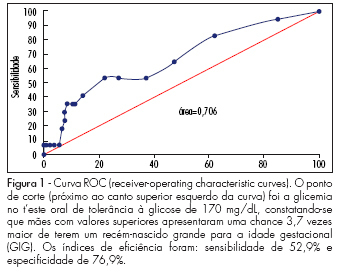Revista Brasileira de Ginecologia e Obstetrícia. 2009;31(1):5-9

PURPOSE: to evaluate factors related to the presence of neonatal macrosomia in pregnant women with gestational diabetes mellitus. METHODS: 157 pregnant women presenting gestational diabetes mellitus in follow-up were retrospectively selected from January 2004 to July 2006. This group has been divided into two subgroups: one with newborns with weight in accordance with the gestational age (n=136) and another with macrosomic newborns (n=21). Maternal characteristics have been compared between the groups. The t-Student test was used for the analysis of equality hypothesis between the averages of the two groups, and chi-square test, to check the groups’ homogeneity concerning ratios. RESULTS: the groups did not show any significant difference concerning the gestational age, body mass index, weight gain along the gestation, number of previous pregnancies, fast glycemia in the oral glucose tolerance test after the ingestion of 75 g (TOTG 75 g), gestational age at delivery, glycemic values during the treatment, and the type of treatment used (p>0.05). In the group with neonatal macrosomia, there was a higher two-hour-glycemia in the TOTG 75 g (p=0.02), higher gestational age at the treatment onset (p=0.02), and a lower number of appointments at the health service (p<0.01). When adjusted to a logistic regression model, the most important factor (p<0.01) found to predict neonatal macrosomia was the two-hour-glycemia in the TOTG 75 g. CONCLUSIONS: the factors more frequently related to neonatal macrosomia were late treatment onset and, consequently, lower number of appointments and chiefly, high two-hour-glycemia in the TOTG 75 g.
Search
Search in:


Comments